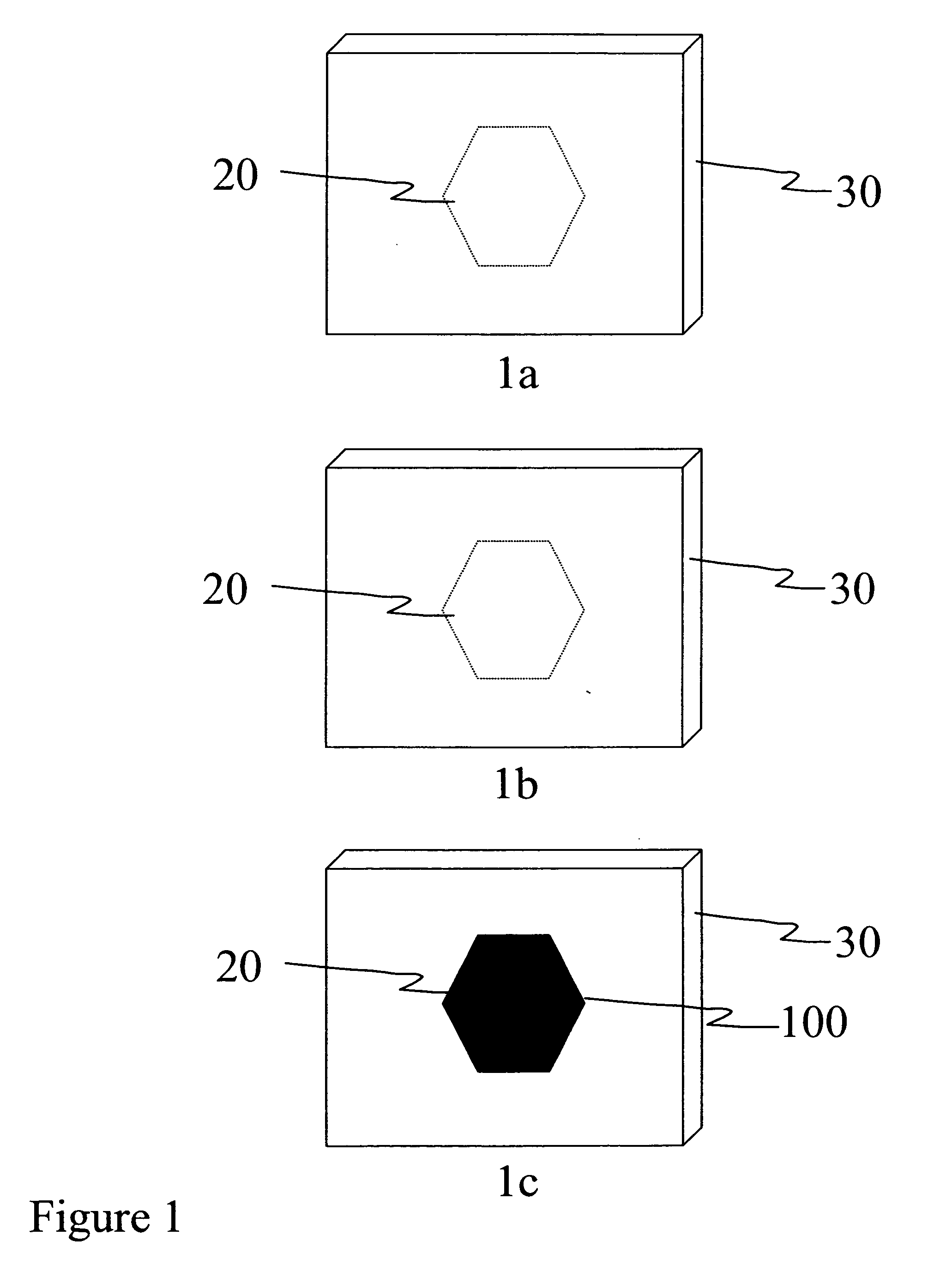Media for detection of X-ray exposure
a technology for x-ray exposure and media, applied in the field of x-ray detection devices, can solve the problems of reducing requiring very large x-ray doses, and affecting the detection efficiency of x-ray radiation,
- Summary
- Abstract
- Description
- Claims
- Application Information
AI Technical Summary
Benefits of technology
Problems solved by technology
Method used
Image
Examples
example 1
[0030] Inorganic materials were exposed to an X-ray beam for specified time and defined X-ray source voltage and current settings. These materials showed a color change as detailed in Table 1.
TABLE 1Effect of X-ray Exposure on X-ray Sensitive Inorganic MaterialsMaterialX-rayColorMaterialX-raySourceBeforeColor AfterX-raySourceCurrentExposureX-rayX-rayMaterialSourceKilovoltsMilliampsTimeExposureExposurePotassiumX-ray tube75401 minuteWhitePurplechloridePotassiumX-ray tube75403 minutesWhitePurplechlorideSodiumX-ray tube75401 minuteWhiteLight BluebromideSodiumX-ray tube75401 minuteWhiteGoldenchlorideYellowPotassiumX-ray tube75401 minuteWhiteGreeniodideZirconiumRotating503001 minuteWhiteBlackoxideAnodeZirconiumRotating503005 minutesWhiteBlackoxideAnodeSodiumRotating503005 minutesWhiteLight PinkBicarbonateAnodeSilverRotating503003 minutesWhiteBrownSulfideAnodeTin OxideRotating503005 minutesLight GrayDark GrayAnode
[0031] All materials in Table 1 showed a color change upon X-ray exposure w...
example 2
[0034] Organic materials were exposed to an X-ray beam for specified time and defined X-ray source voltage and current settings. These materials showed a color change as detailed in Table 2.
TABLE 2Effect of X-ray Exposure on X-ray Sensitive Organic MaterialsMaterialX-rayColorMaterialX-raySourceBeforeColor AfterX-raySourceCurrentExposureX-rayX-rayMaterialSourceKilovoltsMilliampsTimeExposureExposureHTDX-ray tube75402 minuteWhiteDark PinkCIN 10082837CD2X-ray tube75403 minutesWhiteDark Pink
[0035] All materials in Table 2 showed a color change upon X-ray exposure without any chemical or physical processing steps. All materials in Table 2 do not show a color change upon exposure to ambient light, including ultraviolet light.
example 3
[0038] Polymeric materials were exposed to an X-ray beam for specified time and defined X-ray source voltage and current settings. These materials showed a color change as detailed in Table 3.
TABLE 3Effect of X-ray Exposure on X-ray Sensitive Polymeric MaterialsMaterialX-rayColorMaterialX-raySourceBeforeColor AfterX-raySourceCurrentExposureX-rayX-rayMaterialSourceKilovoltsMilliampsTimeExposureExposure5 minuteX-ray tube7540 1 secondClearYellow-DevconorangeEpoxy5 minuteX-ray tube7540 5 secondsClearYellow-DevconorangeEpoxy5 minuteX-ray tube754010 secondsClearYellow-DevconorangeEpoxy5 minuteX-ray tube754015 secondsClearYellow-DevconorangeEpoxy
[0039] The materials in Table 3 showed a color change upon a wide range of X-ray exposure times without any chemical or physical processing steps. All materials in Table 3 do not show a color change upon exposure to ambient light, including ultraviolet light.
PUM
 Login to View More
Login to View More Abstract
Description
Claims
Application Information
 Login to View More
Login to View More - R&D
- Intellectual Property
- Life Sciences
- Materials
- Tech Scout
- Unparalleled Data Quality
- Higher Quality Content
- 60% Fewer Hallucinations
Browse by: Latest US Patents, China's latest patents, Technical Efficacy Thesaurus, Application Domain, Technology Topic, Popular Technical Reports.
© 2025 PatSnap. All rights reserved.Legal|Privacy policy|Modern Slavery Act Transparency Statement|Sitemap|About US| Contact US: help@patsnap.com



